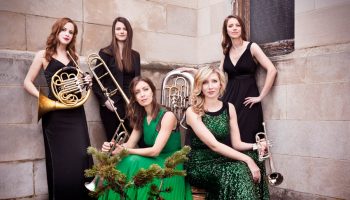
Chautauqua School of Music’s Alexander Gavrylyuk, Heintzelman Family Artistic Adviser of the Piano Program, and Aaron Berofsky, violin faculty and chair of strings, will perform together at 4 p.m. Saturday, June 29 in Elizabeth S. Lenna Hall, in the first recital of the 2019 Chautauqua Chamber Music Resident Artist Series.
Gavrylyuk and Berofsky will play three pieces: Johannes Brahms’ Sonata No. 2 in A major, Robert Schumann’s Sonata No. 1 in A minor and Sergei Prokofiev’s Sonata No. 2 in D major.
“They’re such introspective, beautiful pieces, and in a way they have that in common with each other,” Berofsky said. “At the same time, they’re stylistically very different.”
Gavrylyuk said the pieces are some of the most well-known violin and piano sonatas; both artists are familiar with them and have played them many times before.
“It’s like a friend you keep revisiting,” Berofsky said.
Brahms’ piece is about 20 minutes long, Berofsky said, and is probably the gentlest of the three pieces.
“It is a very philosophical work,” Gavrylyuk said. “It’s structured very much like a baroque building … with a very solid foundation but with a very delicate structure above the foundation. It is quite humorous at times; at other times it is very romantic and very lyrical. I think one hears the songs of love there, as well as prayers (and) intimate moments.”
The piece begins with the marking Allegro amabile, which essentially translates to “fast and friendly,” evoking a mood that continues throughout the piece.
“It’s very kind and open-hearted, so I feel very close to that piece,” Berofsky said.
The Schumann piece is a bit shorter, around 17 to 18 minutes long. It is an unusual choice for violin, Berofsky said, and the violinist must be flexible with the pianist while playing.
“Schumann has led a very tormented life, and one can hear it in his music,” Gavrylyuk said. “It’s kind of a bittersweet first movement, followed by a very elegant and very tender kind of second movement, and the third movement is very dramatic and determined.”
The Schumann piece is an interesting companion to the Brahms, Berofsky said, because both pieces have thematic elements of love — and both men loved the same woman: Clara, Schumann’s wife. He described the piece as “crazed and kind of hyper” at times, but also as “a love theme.”
“It’s very tender,” Berofsky said. “The emotions go from zero to 60, really quickly.”

The Prokofiev piece is a bit longer than the others, clocking in around 25 minutes — standard timing of a sonata from the late Romantic-period, Berofsky said.
This piece is markedly different from the others in its overall tone.
“Prokofiev was a master in creating this kind of very sarcastic reflection of reality,” Gavrylyuk said. “This sonata is definitely not an exception to that. It’s a very ironic sort of piece.”
However, the piece fits well with the others in that it contains both the intimacy of Brahms and the storminess of Schumann.
“Each piece has its own moments of repose and then moments of wildness,” Berofsky said.
This is the second year for the Chautauqua Chamber Music Resident Artist Series, which gives music faculty a chance to perform in a smaller setting, not just in concerts accompanied by an orchestra.
“Chamber music is just the most intimate and deep way of communicating through music,” Berofsky said. “It’s very personal. There’s no hiding. … (It’s) about communicating the deepest emotions and making people come together through music.”
Unlike solo recitals where the artist is alone with the audience, and concertos where the whole orchestra shares the music, chamber music is like a conversation between just a few musicians.





